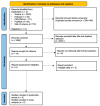Plasma Exchange versus Intravenous Immunoglobulin in Worsening Myasthenia Gravis: A Systematic Review and Meta-Analysis with Special Attention to Faster Relapse Control
- PMID: 38137401
- PMCID: PMC10740589
- DOI: 10.3390/biomedicines11123180
Plasma Exchange versus Intravenous Immunoglobulin in Worsening Myasthenia Gravis: A Systematic Review and Meta-Analysis with Special Attention to Faster Relapse Control
Abstract
Currently used rescue interventions to prevent rapid myasthenic deterioration are plasma exchange (PLEX) and intravenous immunoglobulin (IVIG). We investigated the evidence to determine whether the two methods were interchangeable or whether one was superior to the other. This review was registered on PROSPERO (CRD42021285985). Only randomized controlled trials (RCTs) comparing the efficacy and safety of PLEX and IVIG in patients with moderate-to-severe myasthenia gravis (MG) were included. Five major databases were systematically searched (PubMed, CENTRAL, Embase, Scopus, and Web of Science). Odds ratios (OR) with 95% confidence intervals (CI) were calculated for adverse events and mean differences (MD) for changes in quantitative myasthenia gravis scores (QMG). Three RCTs met the inclusion criteria. Two investigating 114 patients in total were eligible for meta-analysis to analyze efficacy and safety. For the change in QMG score, the MD was -2.8 (95% CI: -5.614-0.113), with PLEX performing better. For adverse events, an OR of 1.04 was found (95% CI: 0.25-4.27). This study demonstrated a low risk of bias in evaluating treatment efficacy but indicated a high risk of bias in assessing procedural safety outcomes. Although the results did not show any significant difference, there was a tendency indicating faster efficacy of PLEX in the first two weeks of treatment. In such a critical clinical condition, this tendency may be clinically meaningful, but further studies should clarify this benefit.
Keywords: intravenous immunoglobulin; meta-analysis; myasthenia gravis; plasma exchange; relapse.
Conflict of interest statement
The authors declare no competing interest.
Figures




References
Publication types
LinkOut - more resources
Full Text Sources
Miscellaneous

